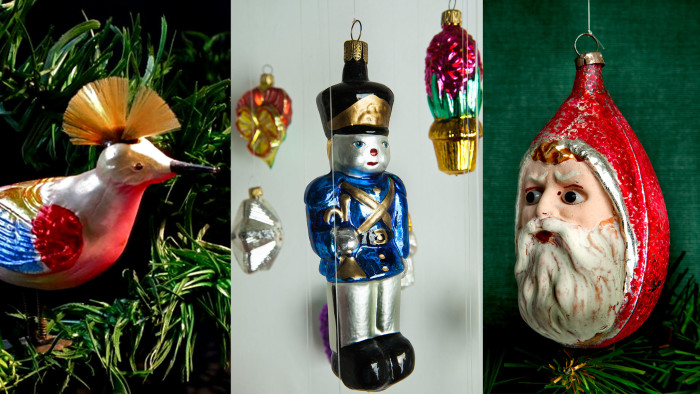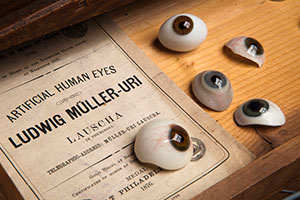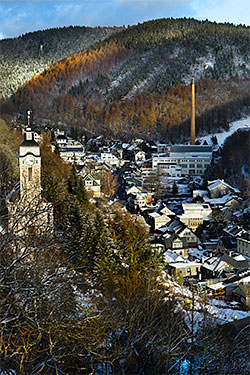The business of baubles — and the town that invented them

Simply sign up to the Life & Arts myFT Digest -- delivered directly to your inbox.
In the late 1940s, a number of girls in Germany excitedly unwrapped their Christmas gifts only to find they had been given blind dolls: the toys were missing their glass eyes. The episode was one of the more curious outcomes of the second world war, a memory absent from the Germany: Memories of a Nation exhibition running at the British Museum (until January 25) but recorded in Edith Sheffer’s book Burned Bridge (2014).
It happened like this: in 1948 the local industries of East Germany’s Soviet zone were state-controlled. Very close to the border with West Germany in Thuringia was a small town called Lauscha. Its speciality had been handcrafted blown glass, and among its products were glass eyes for dolls, of the sort Germany was famed for, with rolling eyelids, lace clothing, ruddy cheeks and the sense that in the small hours they might come alive.
This was the age of austerity in the communist east, and the West German border city of Neustadt took advantage of Lauscha’s predicament by employing any of its glassworkers who had escaped from the east. The West German border patrol turned a blind eye, while the East German authorities castigated the defectors as “vermin” and “egoists”. Yet, as happens in capitalist economies, local entrepreneurs in Neustadt saw the opportunity for supply to meet demand, and the age of blind dolls ended in the early 1950s.
The cold war era was just a blip in the history of Lauscha’s glassworks, and its traditional industries were much restored when the Berlin Wall came down in 1989. It has since traded on the town’s greatest legacy, not dolls’ eyes (although they are still made there) but something much less sinister. It was the birthplace of the Christmas bauble in its myriad variations.
Lauscha’s Strasse des Friedens is the global epicentre of handmade tree decorations, or Christbaumschmuck Zentral. The town’s location in a forest at an elevation of 2,000ft offered the perfect conditions for glassmaking, with fine sand from Steinheid, local limestone, and countless trees dragged down the mountainside to be burnt both for kiln fuel and to create potash for the glass compound. The iron-rich geology yielded a green cast to the glass, which seemed quite at home in this wooded landscape. Armed with these raw ingredients and a cartload of optimism, the town’s medieval community set up Glashutten (glass huts), each a true cottage industry.
More than four centuries ago, the Greiner family blew an economic bubble for themselves. In the 1590s, Hans Greiner and Christoff Mueller set up shop in Lauscha with a licence from the Duke of Saxe-Coburg, Johann Casimir. The town’s Hüttenplatz (foundry place) still marks the spot. Glass was expensive stuff, and not for those who drank from pitch-lined leather. For the aristocracy, Venice and Germany enjoyed a strong trading relationship across the Alps, and Venetian-style drinking glasses were prized, as well as flasks for prized liquids. Painted glassware offered a more popular alternative, and glass gradually gained currency as an everyday material.

One of the Griener & Mueller products was seasonal garlands of glass beads that were draped over trees. During this period das lametta, or tinsel, was developed from strips of silver. The problem was it would tarnish in sulphuric air, unlike the wipe-clean glass beads.
The market for Lauscha glassware expanded into the 17th century, and Mueller’s sons built a factory in 1607, while other glassworkers in the region formed fraternities to purchase the land and resources that the hungry industry consumed. By the late-18th century, demand had peaked and Glashutten were dotted throughout the town, producing drinking glasses, bottles, beads and, by 1835, glass eyes for doll makers and taxidermists. German traditions were widely exported, and principal among them was the Tannenbaum — the Christmas tree. One was apparently recorded in 1419 as a marketing triumph of the bakers of Freiburg, an arboreal sampling station in the city square, laden with nuts and baked goods for children to pick. This was the tradition imported into England at the start of the 19th century by George III’s wife, Charlotte of Mecklenberg-Strelitz.

In 1800 at Queen’s Lodge, Windsor, Dr John Watkins wrote: “ . . . in the middle of the room stood an immense tub with a yew-tree placed in it, from the branches of which hung bunches of sweetmeats, almonds, and raisins in papers, fruits and toys, most tastefully arranged, and the whole illuminated by small wax candles. After the company had walked around and admired the tree, each child obtained a portion of the sweets which it bore together with a toy and then all returned home, quite delighted.”
Princess Victoria enjoyed a tree with ornaments at Kensington Palace in 1832. But the real turning point came in 1848 when a picture in the Illustrated London News of Victoria’s and Prince Albert’s festive spruce with gifts beneath and royal children gazing in wonder set off the fashion to display a piece of Germanic forest in living rooms across the country.
It was in this period that Hans Greiner, a descendant of the first, began to make glass ornaments in the shape of nuts, fruits and assorted deliciousness, in the long tradition of the bakers of Freiburg. Yet the round baubles recorded in 1847 would break the mould: they were made by inserting a hot glass tube into a clay former and blowing it to fill its simple contours. The interior surfaces had a silvered appearance through lethal compounds of lead or mercury, later replaced by silver nitrate. The German term for such a bauble is kugel but if you mail order some in a hurry, you should know it is also the word for a Jewish noodle pie that might be less appetising draped over your spruce.
German immigrants in Pennsylvania and Ohio had brought trees into American homes in the 18th century, but in 1842 the Reverend Charles Minnegrode is said to have introduced a decorated tree to Williamsburg, Virginia, with gilded nuts, candles and popcorn strings. No sign of baubles, but the transatlantic market was ripe for Lauscha’s glassy globes.
The man who took the opportunity was 28-year-old Frank Woolworth. In 1880, this early triumph for his empire of nickel-and-dime stores wasn’t obvious when a travelling German salesman visited his store in Lancaster, Pennsylvania, and offered him some Lauscha ornaments. Woolworth through they were unmarketable because they didn’t do anything, being mere baubles. Yet he reluctantly agreed to take them on a sale-or-return basis. The glass baubles sold in one day with a profit of $4.32.
A century or so on, with the doll-eye fiasco well behind it, Lauscha is today recovering a trade it has upheld for centuries. If China is now producing cheap ornaments more cheaply, then the crafted product must innovate and command a premium, as House & Home demonstrated last month with our very own limited-edition “Pink ’un” bauble costing £75. In 2008 Krebs Glas Lauscha created a gold and diamond bauble worth €20,000. The following year, Hallmark in the UK responded with one priced at £82,000. So let records be smashed — for making baubles is a serious business.
Photographs: Karin Jansky-Barron; Kalle Koponen/ Caters News
Comments